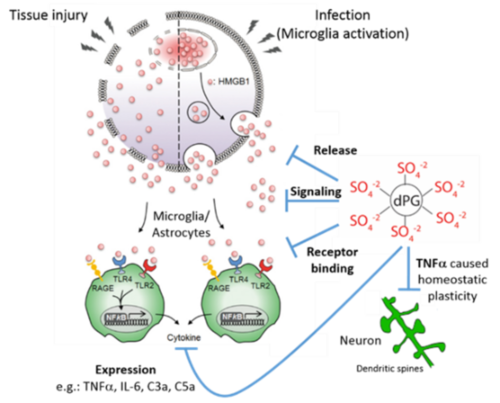Project B2 | Dendritic polysulfates as neuroprotective agents
Achazi / Dernedde / Maysinger / McKinney
In project B2, physical measurements and molecular modeling data will be related to the biochemical measurements, imaging and functional analyses of glial and neuronal cells. The focus is on the alarmin and transcription factor high mobility group box 1 (HMGB1) and its interactions with polyelectrolytes such as dendritic polyglycerol sulfates (dPGS).
Polyanions and their conjugates allow tracking and manipulation of mechanisms in neural cells based on their affinity to bind specifically to intracellular and cell surface proteins. Different scaffold architectures in combination with imaging modalities, will allow for the detection and modulation of processes in neural cells. Mechanisms to be studied are the modulatory effects of polyelectrolytes on central nervous system neurons, astrocytes and microglia, in hyperactive states. Changes in synaptic structures and function (electrophysiology) induced by polyanions will be monitored in a temporal and spatial manner. Key signalling pathways implicated in attenuating glial activation will also be investigated. To unravel the mechanisms behind these processes at the molecular level, an in-depth analysis of the interaction of polyelectrolytes with selected proteins will be performed.
Investigating the functional significance of polyelectrolyte charge density, spatial arrangement, impact on protein folding and protein clustering are essential components of this working plan. The translocation of HMGB1 will be followed using a time-lapse approach with confocal microscopy provided by the Achazi lab. The post-translational modifications of HMGB1 will be analyzed using mass spectrometry in cooperation with project A2. Binding of HMGB1 dPGS will be monitored using SPR in the Dernedde group. Guided by the expression of individual protein domains the linkage of suitable probes will furthermore allow for spectroscopic analyses in cooperation with A3. Finally, the experimental data will be complemented by modeling approaches. Predictions from these calculations will enable the design of optimized dPGS analogs to bind with high specificity and affinity to HMGB1 to reduce its deleterious effects.
Subjects: Biochemistry | Biophysics | Pharmacology
